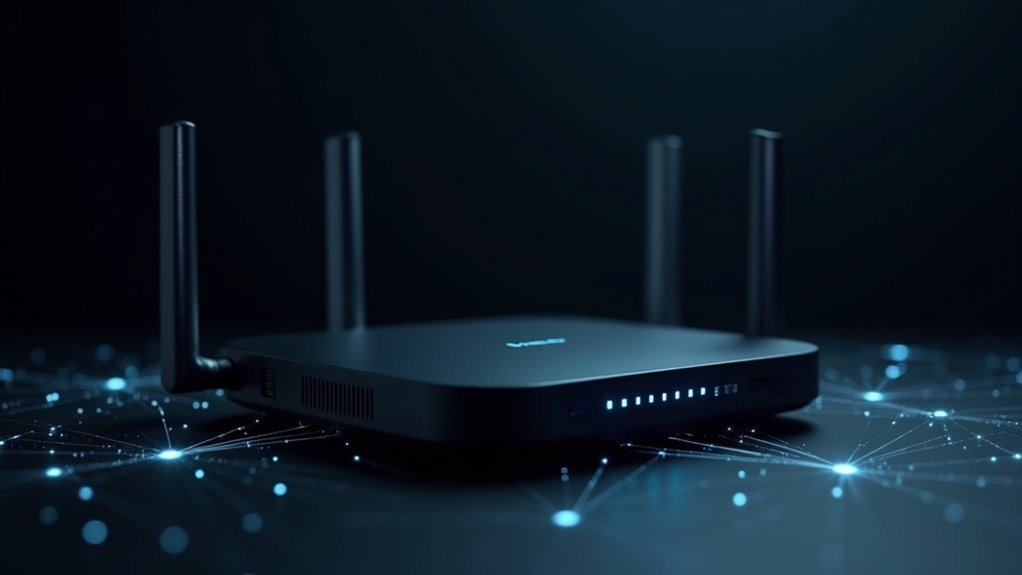You’ve probably experienced the frustration of walking from room to room only to watch your WiFi signal drop to nothing. Traditional routers simply can’t handle today’s connected homes where dozens of devices compete for bandwidth simultaneously. Advanced mesh systems solve these problems through revolutionary architecture that fundamentally changes how your network operates. But what specific technologies make them so much more effective than conventional setups?
Understanding Mesh Network Architecture and Node Communication

When you deploy a mesh WiFi system, you’re fundamentally creating a network of interconnected nodes that function as a unified team rather than isolated access points.
The mesh network architecture enables multiple nodes to communicate directly with each other and your devices simultaneously. This node communication creates a seamless network where your device automatically connects to the strongest available signal.
Each node employs dedicated backhaul channels that dramatically boost data transfer speeds across your entire coverage area.
When you move through your home, the system’s automatic signal rerouting guarantees uninterrupted connectivity by seamlessly transferring your connection between nodes.
The self-healing capabilities mean if one node experiences issues, others immediately compensate, maintaining robust performance without manual intervention needed.
Seamless Coverage Elimination of Dead Zones
You’ll experience uninterrupted connectivity throughout your entire space thanks to advanced mesh systems that strategically position multiple satellite nodes to create overlapping coverage zones.
Each node communicates with nearby devices and other nodes simultaneously, automatically directing your connection to the strongest available signal as you move between rooms.
This intelligent network architecture guarantees you’ll never encounter frustrating dead zones or signal dropouts, even in challenging layouts where traditional routers typically fail.
Multi-Node Network Architecture
Advanced mesh WiFi systems transform how networks deliver coverage by deploying multiple interconnected nodes that work together as a unified system.
This multi-node network architecture guarantees consistent coverage throughout your entire space, with each node covering up to 3,000 square feet. You’ll experience peak signal strength as devices automatically connect to the nearest, strongest node without manual intervention.
The system’s self-healing technology automatically reroutes traffic if any node fails, maintaining uninterrupted connectivity. Your devices seamlessly shift between nodes as you move, eliminating connection drops.
This architecture supports high-demand applications like gaming and streaming simultaneously without performance degradation. Multiple devices can operate at full capacity, making mesh networks ideal for modern homes and offices requiring robust, reliable connectivity across expansive areas.
Strategic Satellite Placement
Strategic satellite placement forms the backbone of eliminating dead zones and achieving seamless coverage throughout your property.
You’ll want to position satellites in high-traffic areas and locations with thick walls to maximize signal strength and guarantee reliable connectivity. Each satellite covers approximately 3,000 square feet, so you can strategically place them where signals overlap effectively.
Your mesh system automatically adjusts connection paths between nodes, maintaining strong signals even when satellites are moved or obstructed, preventing interrupted connectivity.
Each node communicates directly with nearby satellites, minimizing latency and maintaining high speeds in complex layouts.
You can expand coverage by adding more satellites as needed, allowing you to customize WiFi setup based on your specific property demands and persistent connectivity challenges.
Automatic Signal Handoff
Building on prime satellite positioning, automatic signal handoff technology guarantees your devices maintain the strongest possible connection as you move throughout your home.
Your smartphone, laptop, or tablet seamlessly shifts between nodes without dropping signals or requiring manual reconnection. This mesh network intelligence continuously monitors signal strength, instantly switching your device to the nearest node with peak performance.
You’ll experience uninterrupted connectivity even in challenging areas where traditional routers create dead zones. Each node communicates with neighboring units, dynamically enhancing your connection path.
Advanced systems provide overlapping coverage areas exceeding 3,000 square feet per satellite, ensuring seamless connectivity throughout complex layouts. Whether you’re streaming in the basement or video calling upstairs, automatic signal handoff eliminates weak spots and maintains consistent performance across your entire coverage area.
Advanced Signal Handoff Technology
You’ll experience uninterrupted connectivity as advanced mesh systems employ sophisticated signal handoff technology that enables your devices to switch seamlessly between nodes without dropping connections.
The system automatically optimizes your signal by continuously monitoring network conditions and selecting the strongest connection from the nearest node in real-time.
This intelligent switching happens behind the scenes, ensuring you maintain high-speed internet whether you’re streaming in the living room or working in your home office.
Seamless Device Transitions
As you move through your home or office, advanced mesh WiFi systems automatically transfer your devices between access points without dropping connections or causing noticeable delays.
This seamless handoff technology guarantees your devices always connect to the strongest signal available, maintaining peak performance for demanding activities.
The system’s intelligent communication between nodes delivers three key benefits:
- Millisecond shifts that keep your streaming and gaming sessions uninterrupted
- Dynamic traffic routing that prevents bottlenecks and maximizes network speed
- Multi-band support that automatically selects the best frequency for connection stability
You’ll experience reliable WiFi throughout your entire space as the system continuously monitors signal strength and automatically switches your devices to the most efficient access point, assuring consistent performance whether you’re video conferencing or streaming content.
Automatic Signal Optimization
Advanced mesh systems continuously monitor your network environment to deliver ideal signal strength through sophisticated automatic signal optimization algorithms.
Your devices automatically connect to the strongest available signal, ensuring you’re always getting peak performance without manual intervention. The seamless handoff technology between mesh nodes maintains uninterrupted connectivity as you move throughout your space, eliminating dropped connections and dead zones.
This intelligent data distribution considerably reduces latency while enhancing network reliability, particularly essential for high-bandwidth activities like 4K streaming and online gaming.
When one node encounters interference or fails, the system instantly adjusts communication paths to maintain robust connections. Under best conditions, you’ll experience speeds up to ten times faster than traditional routers as the network efficiently distributes data based on real-time demands.
Multi-Device Performance and Bandwidth Management

When your household runs multiple devices simultaneously—from smartphones and laptops to smart TVs and IoT gadgets—traditional routers often buckle under the pressure, creating frustrating slowdowns and connectivity issues.
Advanced mesh systems excel at multi-device performance through sophisticated bandwidth management that keeps your network running smoothly.
Advanced mesh technology delivers seamless multi-device connectivity through intelligent bandwidth distribution that eliminates network bottlenecks and performance drops.
These systems use intelligent bandwidth allocation to prioritize traffic based on your activity, ensuring gaming and streaming get the resources they need.
With WiFi 6 support and real-time monitoring, you’ll experience:
- Tri-band and quad-band configurations that create dedicated channels for different devices
- Adaptive routing capabilities that automatically adjust to traffic patterns
- Reduced network congestion through optimized performance distribution
Your connected devices work harmoniously together, eliminating the frustration of competing for bandwidth.
Self-Healing Network Capabilities
When your mesh network encounters a node failure or interference, you don’t need to manually troubleshoot or restart devices.
Advanced mesh systems automatically detect these issues and reroute your internet traffic through alternative pathways, maintaining your connection without interruption.
This self-healing capability means you’ll experience seamless connectivity even when individual nodes go offline or face signal obstructions.
Automatic Traffic Rerouting
While traditional routers create single points of failure that can knock out your entire network, mesh WiFi systems employ sophisticated self-healing technology that automatically reroutes traffic when problems arise.
This automatic traffic rerouting guarantees seamless connectivity by continuously monitoring each node’s health and performance.
Your mesh system’s intelligent traffic management operates through three key mechanisms:
- Real-time node monitoring – Constantly checks hardware status and connection quality
- Dynamic path refinement – Instantly redirects devices to less congested nodes
- Load balancing – Distributes multiple devices across available nodes for maximum efficiency
When interference or overloading occurs, the system switches your devices to functioning nodes without interruption.
This maintains consistent connectivity throughout your space, guaranteeing network efficiency remains ideal even during hardware malfunctions or peak usage periods.
Node Failure Recovery
Beyond simple traffic rerouting, your mesh system’s self-healing capabilities kick into overdrive during actual node failures, automatically restructuring the entire network topology to maintain seamless connectivity.
When a node goes offline, the remaining nodes communicate instantly to establish alternative pathways, ensuring uninterrupted connectivity throughout your home. This self-healing technology enhances network reliability by eliminating single points of failure that plague traditional router setups.
Your mesh network’s dynamic adjustment capabilities allow it to optimize data routes in real-time, compensating for hardware failures without manual intervention.
Even during critical node failure scenarios, you’ll experience minimal impact on internet speed and performance. This seamless recovery process proves essential for high-demand applications like 4K streaming and online gaming, where connectivity interruptions simply aren’t acceptable.
WiFi 6 and WiFi 6E Integration Benefits

As mesh WiFi systems evolve to incorporate WiFi 6 and WiFi 6E technologies, you’ll experience dramatically enhanced network performance that transforms how your devices connect and communicate.
These advanced standards deliver faster speeds up to 9.6 Gbps while providing improved range through sophisticated beamforming technology that precisely targets your connected devices.
Your mesh network gains three critical advantages with WiFi 6 and WiFi 6E integration:
- Simultaneous multi-device connectivity – OFDMA technology allows multiple devices to share channels efficiently without speed degradation.
- Enhanced security protocols – WPA3 encryption provides superior protection against cyber threats and unauthorized access.
- Reduced network congestion – WiFi 6E’s additional 6 GHz band eliminates interference in dense environments.
These improvements make modern mesh systems perfect for smart homes requiring seamless connectivity across numerous IoT devices.
Dedicated Backhaul Channels for Optimal Performance
You’ll find that dedicated backhaul channels create a separate communication highway between your mesh nodes, preventing interference with your device connections.
This technology dramatically boosts your network’s speed by ensuring data flows efficiently between nodes without competing for the same wireless bands your devices use.
Your mesh system can then optimize traffic management across your entire home, maintaining consistent performance even when you’re streaming, gaming, or running multiple smart devices simultaneously.
Backhaul Technology Explained
When advanced mesh WiFi systems need to maintain peak performance across multiple nodes, they rely on dedicated backhaul channels that operate separately from your main WiFi bandwidth.
This backhaul connection guarantees fast data transmission between nodes without competing for resources with your connected devices.
Advanced mesh router features typically include tri-band technology that allocates one band exclusively for backhaul communication.
This approach delivers three key benefits:
- Enhanced Network Stability – Nodes communicate seamlessly without interrupting your device connections
- Superior Signal Strength – Coverage extends across larger areas without bandwidth degradation
- Peak Bandwidth Efficiency – Up to 40% faster speeds compared to traditional setups
You’ll experience smoother streaming, gaming, and smart home functionality as your mesh system maintains prime performance even during high-demand scenarios across multiple devices.
Speed Enhancement Benefits
Since dedicated backhaul channels create separate pathways for inter-node communication, your mesh system can deliver dramatically faster speeds without the bottlenecks that plague traditional WiFi setups. These speed enhancement benefits enable multiple devices to operate simultaneously without performance degradation.
| Feature | Traditional WiFi | Dedicated Backhaul Channels |
|---|---|---|
| Network Efficiency | Shared bandwidth creates congestion | Separate pathways eliminate interference |
| Device Capacity | Performance drops with multiple devices | Maintains peak performance across all connections |
| High-Bandwidth Applications | Struggles with 4K streaming | Supports demanding applications seamlessly |
Your mesh system’s dedicated backhaul channels operate on different frequencies, ensuring 4K streaming, gaming, and browsing don’t compete for the same data pathway. This configuration can achieve speeds up to 27Gbps, making high-speed internet plans fully utilizable.
Network Traffic Optimization
While traditional routers force all network traffic through the same channels, advanced mesh WiFi systems with dedicated backhaul channels intelligently separate data flows to prevent congestion and optimize performance.
These systems revolutionize network traffic optimization by creating dedicated pathways between nodes, ensuring your device communications don’t interfere with inter-node data transfer.
Tri-band technology enhances bandwidth allocation through three key advantages:
- Separate 5GHz backhaul channel exclusively for node-to-node communication
- Reduced network congestion by isolating device traffic from mesh coordination
- Enhanced bandwidth distribution across all connected devices simultaneously
This sophisticated approach delivers lower latency and reliable performance for demanding activities like 4K streaming and online gaming.
You’ll experience consistently faster speeds because dedicated backhaul channels prevent the bottlenecks that plague traditional dual-band routers.
Intelligent Band Steering and Load Balancing
As your devices compete for bandwidth across your home network, intelligent band steering and load balancing work together to enhance performance automatically. Advanced mesh systems guide your devices between 2.4 GHz and 5 GHz frequencies, guaranteeing superior connections while preventing congestion. Load balancing distributes network traffic evenly across nodes, preventing bottlenecks that compromise performance.
| Feature | 2.4 GHz Band | 5 GHz Band |
|---|---|---|
| Range | Longer reach | Shorter range |
| Speed | Moderate speeds | Higher speeds |
| Congestion | More crowded | Less interference |
| Device Types | Smart home devices | Gaming, streaming |
| Wall Penetration | Better penetration | Limited penetration |
Tri-band technology adds dedicated backhaul communication, enhancing efficiency. Dynamic bandwidth allocation prioritizes high-demand activities like gaming and streaming. This intelligent management guarantees seamless connectivity as you move throughout your home, maintaining strong connections without manual intervention.
Enhanced Security Features and Threat Protection
Beyond optimizing performance, advanced mesh WiFi systems prioritize protecting your network and connected devices from sophisticated cyber threats.
These systems integrate enhanced security features that create multiple layers of defense against evolving digital dangers.
Modern mesh networks deliver extensive protection through:
- Real-time antivirus protection that continuously scans all connected devices for malware and malicious attacks
- WPA3 encryption protocols providing stronger wireless security compared to outdated standards
- Built-in firewalls and regular security updates that automatically patch vulnerabilities
You’ll also benefit from robust parental control features that enable customized profiles with age-appropriate content filtering.
Some manufacturers like TP-Link offer free lifetime subscriptions to advanced security services such as TP-Link HomeCare, ensuring your network stays protected without ongoing costs.
Scalability and Network Expansion Options
Since your home’s connectivity needs inevitably grow over time, advanced mesh WiFi systems offer exceptional scalability that adapts to your expanding requirements.
You can easily add additional mesh satellites to extend coverage beyond 6,000 square feet, ensuring consistent performance throughout larger or multi-story homes.
The network expansion process is streamlined through automatic configuration that enhances performance as you integrate new nodes. This eliminates complex setup procedures while maintaining seamless connectivity.
Advanced mesh systems excel in smart homes by supporting numerous IoT devices without compromising speed or reliability.
These systems incorporate sophisticated load balancing and automatic signal handoff capabilities, guaranteeing excellent connectivity across all devices and locations.
You’ll experience consistent performance regardless of how many satellites you add to your network.
Advanced Quality of Service (QoS) Controls
While network expansion capabilities guarantee your mesh system can grow with your needs, the true power of advanced mesh WiFi lies in its ability to intelligently manage network traffic through sophisticated Quality of Service (QoS) controls.
Advanced quality of service features transform your network management experience by automatically identifying device usage patterns and optimizing bandwidth allocation.
You’ll benefit from:
- Intelligent QoS automation that prioritizes gaming consoles and streaming devices without manual user configuration
- Customizable settings through mobile apps for granular control over specific applications
- Optimal performance during peak usage times by reducing latency and buffering
These systems guarantee your smart TVs, video conferencing tools, and gaming devices receive priority bandwidth, minimizing interference from other connected devices.
The result is smoother streaming and reduced lag across all critical applications.
Smart Home Integration and Device Prioritization
Smart home integration represents the next frontier in mesh WiFi technology, where your network becomes the central nervous system connecting everything from smart thermostats to security cameras.
Advanced mesh systems excel at managing multiple IoT devices simultaneously without sacrificing performance or reliability. You’ll benefit from seamless integration that handles numerous connected devices through a single network interface.
Advanced mesh networks seamlessly manage dozens of IoT devices through unified control while maintaining peak performance and rock-solid reliability.
Device prioritization features let you allocate bandwidth to specific applications, ensuring your gaming sessions and streaming remain uninterrupted.
Dedicated mobile apps provide real-time monitoring capabilities, allowing you to adjust settings and control traffic flow effortlessly.
The system’s intelligent architecture automatically adapts to usage patterns, guaranteeing critical devices receive necessary bandwidth during peak times while maintaining ideal smart home functionality.
Professional-Grade Hardware Components
Professional-grade mesh WiFi systems distinguish themselves through cutting-edge hardware that delivers enterprise-level performance for demanding home environments.
You’ll find these advanced hardware components separate premium systems from basic routers:
- Tri-band technology provides a dedicated backhaul channel between nodes, preventing network congestion while maintaining ideal speeds across all connected devices.
- WiFi 6 chipsets enable faster data transmission rates and support notably more simultaneous device connections without performance degradation.
- Enhanced signal amplification technologies extend coverage range and improve wall penetration, ensuring consistent connectivity throughout complex spaces.
These systems also feature multiple high-speed Ethernet ports on each node for wired connections to gaming consoles and streaming devices.
Built-in cybersecurity features protect your network with enterprise-grade encryption and automatic security updates.
Performance Optimization for High-Demand Applications
When you’re streaming 4K content, gaming competitively, or managing multiple video conferences simultaneously, advanced mesh WiFi systems excel at maintaining peak performance through intelligent optimization features. These systems automatically select the fastest band for each device while utilizing tri-band or quad-band technology for dedicated backhaul connections, guaranteeing seamless connectivity even under heavy loads.
| Optimization Feature | Benefit |
|---|---|
| Dynamic bandwidth allocation | Prioritizes resources based on real-time needs |
| Quality of Service (QoS) | Guarantees critical applications receive necessary bandwidth |
| Multi-band management | Supports multiple simultaneous connections without degradation |
Your mesh WiFi systems handle high-demand applications by intelligently managing traffic loads across nodes, minimizing latency while maintaining speeds up to 27Gbps for uninterrupted performance optimization.
Frequently Asked Questions
Why Is Mesh Wifi Better?
You’ll get seamless coverage across large areas without dead zones. Mesh systems automatically connect you to the strongest signal, they’re faster than standard routers, and you won’t juggle multiple network names.
What Is a Major Disadvantage of a Mesh Network?
You’ll face higher upfront costs since mesh networks require multiple nodes instead of one router. You’re also dealing with increased complexity in placement and potentially higher energy consumption from running several devices.
What Is Unique About a Mesh Network?
You’ll find mesh networks create seamless connectivity through multiple interconnected nodes sharing one network name. Unlike traditional setups, you won’t manually switch between networks as devices automatically connect to the strongest available signal.
What Is the Most Important Factor When Considering a Mesh Network?
You’ll find coverage area is the most essential factor when choosing a mesh network. It determines whether you’ll get strong, reliable signals throughout your entire space, especially in larger homes or offices.





Leave a Reply